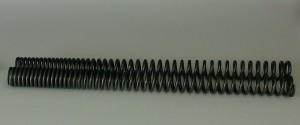These are progressively wound springs. The part where the wire is close together is weak while the part with the wire loops farther apart it stronger.
Yes, I want you to think of springs as stronger or weaker not softer or harder because their job is to hold things up not for you to rest your head upon.
A progressively wound spring starts out weak and gets stronger as you compress it. A straight rate spring gets stronger at the same rate as you compress it. A straight spring with a rate of 100 lbs will compress one inch when you place 100 lbs on it, two inches with 200 lbs and so on. A similar progressive spring will start with a rate of 75 lbs, when that’s used up the stronger rate of 150 lbs takes over.
This sounds nice and comfortable and it is if you are sitting on a coach. But you are riding a motorcycle with suspension that moves fast near the top of it’s travel and slow near the bottom. You want to spend most of your time near the top so the wheels can get out of the way of the bumps. A spring that gives up the best part of the travel as soon as you sit on the bike is not what we want.
What happens when you ride over a bump near the bottom of your travel. The suspension can’t move up fast enough so that end of the bike has to move side to side to make up for the extra distance it has to travel over the bump compared to the other wheel. This is what causes that “cheap wallow” in turns.
So unless you have a fiddle and play it well keep away from the Devil and his agent of despair the progressively wound spring.


